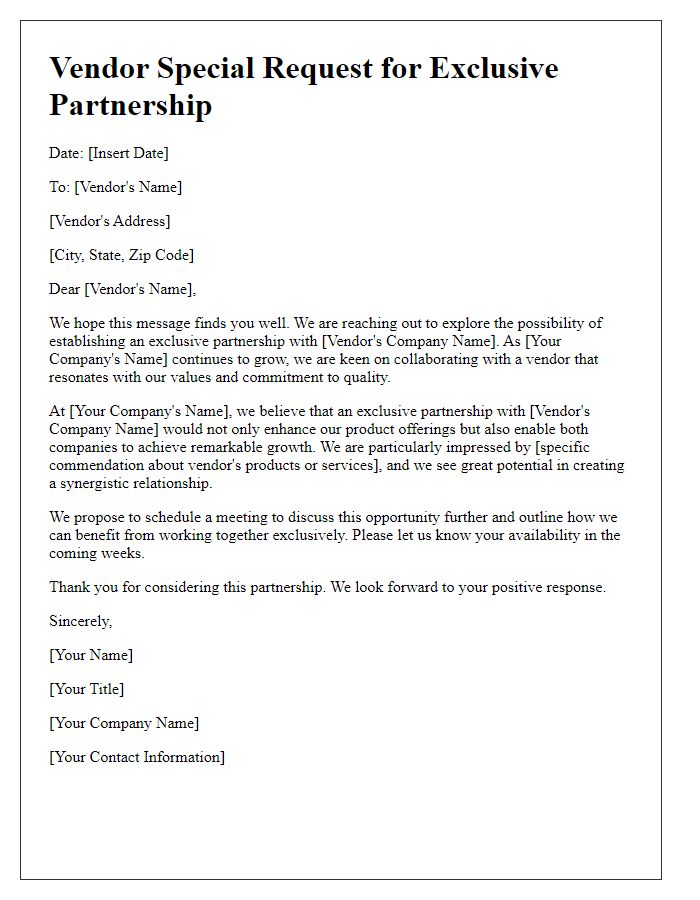When it comes to vendor relationships, clear and effective communication is key, especially when special requests or negotiations arise. It's essential to present your needs in a way that fosters collaboration while ensuring that both parties feel valued and understood. In this article, we'll guide you through crafting a compelling letter that not only outlines your request but also reinforces your partnership with the vendor. Ready to enhance your negotiation skills? Let's dive in!

Clear Objective
Negotiating vendor contracts requires a clear objective to ensure successful outcomes. Key factors include defining specific terms such as pricing, delivery schedules, and quality standards. For instance, a retailer negotiating with a supplier for organic produce may aim to secure a 10% discount on bulk orders while ensuring delivery within 48 hours post-order placement. Establishing metrics for quality assurance, like adherence to USDA Organic Certification, ensures accountability. Providing a detailed proposal outlining these objectives creates a transparent framework for discussions, allowing for constructive dialogue and mutual benefit. Effective negotiation often results in long-term partnerships and optimized supply chain efficiency.
Mutual Benefits
Negotiation between vendors and clients for special requests can entail various strategic considerations, particularly in achieving mutual benefits. Specific requests may include customized pricing structures, extended payment terms, or enhanced product features, which often require thorough discussions and compromises. For example, a vendor could propose a bulk discount for a purchase of over 1,000 units, while the client might offer a commitment to a long-term contract, ensuring continuous business flow over multiple fiscal quarters. Establishing clear timelines for delivery, such as a 30-day lead time for customized orders, can foster trust and efficiency. Both parties should document agreements meticulously, outlining expectations and responsibilities to avoid misunderstandings. This collaborative approach can enhance relationships and drive profitability for both sides, as seen across industries like technology and manufacturing.
Specific Details
Negotiating special requests with vendors requires precise communication of expectations and conditions. Understanding the unique terms is vital for successful transactions. When engaging with a vendor, identify specific item requirements, such as quantity limits (e.g., 500 units), delivery timelines (e.g., within 10 business days), and pricing adjustments (e.g., discounts for bulk orders). Clarifying the brand specifications, including model numbers or quality standards, is essential. Additionally, establish payment terms, like net 30 or upfront deposits, to avoid misunderstandings. Documenting these points ensures alignment between parties and can lead to enhanced relationships and more favorable terms.
Flexibility and Alternatives
When negotiating a vendor special request, maintaining flexibility while exploring alternatives is essential for reaching a satisfactory agreement. A vendor may present specific conditions related to pricing, delivery schedules, or product specifications that require reevaluation. Understanding the market context, including competitors' offerings and regional demand trends, can empower both parties to discuss innovative solutions. For instance, proposing volume discounts or tiered pricing structures based on order quantities can lead to mutually beneficial outcomes. Incorporating alternative delivery methods, such as expedited shipping or local pick-up options, may also help align expectations while addressing logistical challenges. Ultimately, collaboration and effective communication are key factors for successful negotiations in the vendor relationship.
Professional Tone
The negotiation process concerning vendor special requests requires careful planning and clarity in communication. During discussions, specific details about the requested changes should be outlined, including quantities, timelines, and pricing adjustments. Establishing a clear understanding of expectations is crucial for fostering a cooperative relationship. Key points may include specific product specifications, delivery schedules (for example, a 30-day lead time), and potential volume discounts based on order size. It is essential to document all agreements to ensure mutual understanding and prevent any miscommunication in the future. A professional approach fosters goodwill and encourages vendor flexibility, paving the way for successful negotiations.
Letter Template For Vendor Special Request Negotiation Samples
Letter template of vendor special request for payment terms modification

Letter template of vendor special request for additional marketing support

Letter template of vendor special request for extended warranty services











Comments